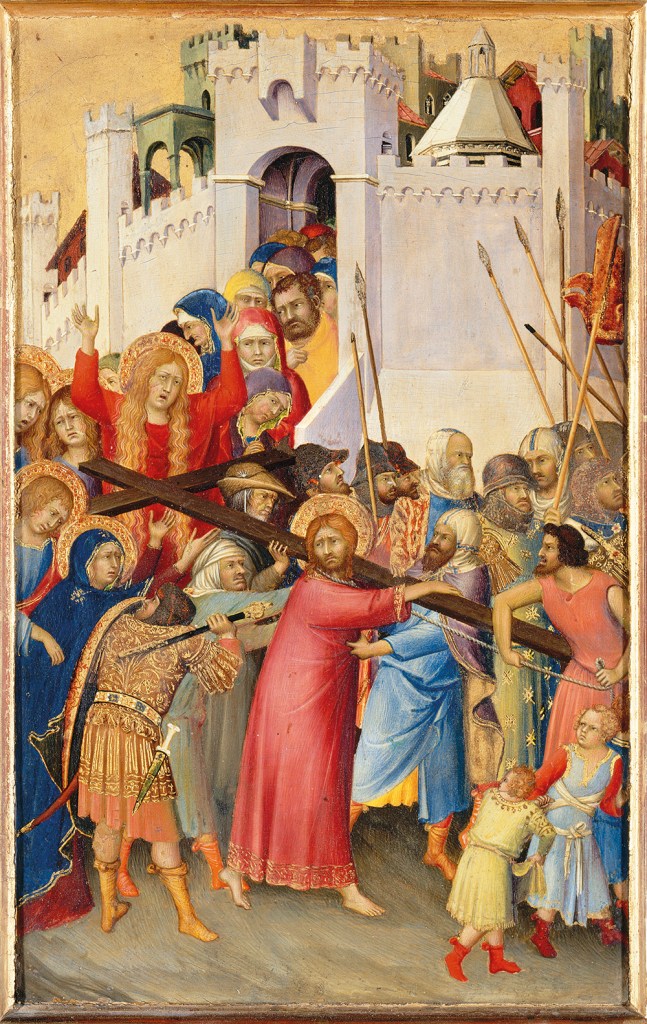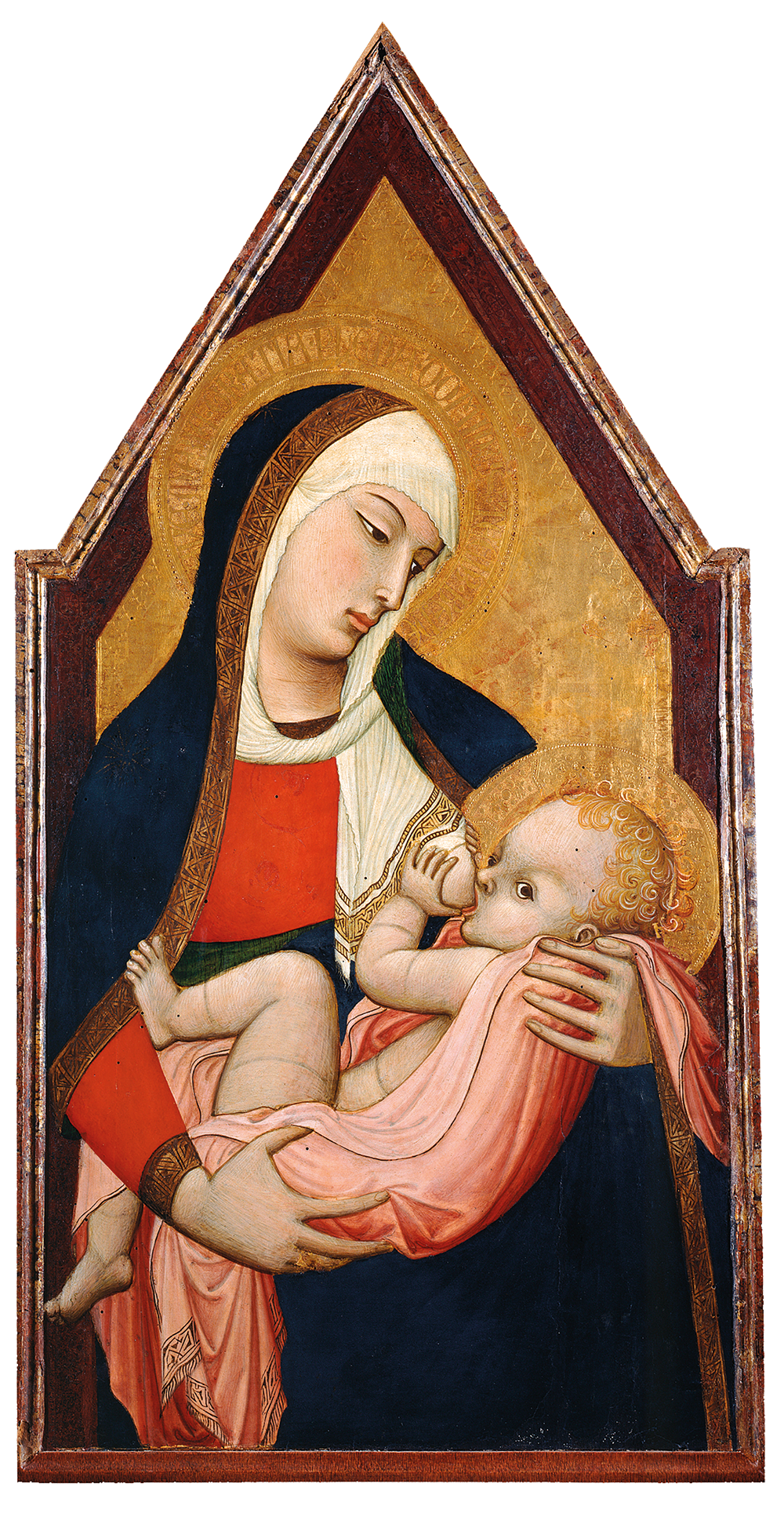
The baby reaches out to touch his mother’s scarf: he studies her face intently, and she focuses entirely on him. There is connection; there is familiarity; there is love. It could be one of the pictures on my phone from last weekend of my daughter with her six-month-old. In fact, it dates from Tuscany c.1290, and the mother and child are the Virgin Mary and Christ.
It’s a small painting, tempera on wood; it’s the opener of the National Gallery’s new blockbuster, Siena: The Rise of Painting 1300-1350; and it’s there to make the show’s fundamental point, which is that its creator, the Sienese Duccio, introduced many of the painterly innovations that paved the way for the Renaissance. With this ‘Virgin and Child’, emotion takes centre stage.
It’s a surprise, because it was Florence, and not its smaller cousin Siena, that went down in history as the birthplace of the Renaissance. And yet in central London this week the evidence is assembled: the novel approach to human gestures pioneered by Duccio is only one of the jigsaw pieces.
Also key to the story is the prosperity enjoyed by Trecento Siena: by the late 1200s it was a major banking centre. And it was sited on the Via Francigena, the main artery for pilgrims travelling between Canterbury and Rome. Trade networks were strong, especially with the all-important Silk Road; and the government, a rotation of nine men elected every two months, was stronger than that of other city states in the region.
This relatively stable, prosperous backdrop, the curators of the Siena show argue, gave the city the essential ingredients to become a breeding ground for artistic creativity. And into this fertile mix stepped the four artists whose work is the focus of this exhibition: the Lorenzetti brothers, Pietro and Ambrogio (c.1280-c.1348 and c.1285-1348/9); Simone Martini (c.1284-1344); and first and foremost, Duccio di Buoninsegna (c.1255-1319), in whose workshop the other three were trained, and whose towering legacy would reshape art history.
Narrative painting of the complexity and scale of Duccio’s ‘Maesta’ had not been seen before
Duccio’s art has survived better than his story. He is thought to have been born in Siena, and the first documents proving that he was paid for a painting date from 1278-9. Other documents show he owned property in the countryside, and hint at a man unafraid to challenge authority – he was fined several times for civil misdemeanours. At some point in the 1280s, he lived and worked in Florence, where he became close to the great Cimabue, and painted many glorious panels and triptychs, including two probably commissioned by one Cardinal Niccolo da Prato. Today one is owned by the National Gallery itself, and the other by the Museum of Fine Arts in Boston; this exhibition reunites them for the first time in centuries.
The London piece hints at one of the reasons for Duccio’s exploration of the psychological. The artwork includes, on the left side panel, St Dominic – unsurprisingly, since Cardinal Niccolo was a Dominican. At the start of the 14th century, that order was trying to make its mark, keen to transform its founder into the kind of knock-’em-dead leader the Franciscans had already managed with their man. And Duccio twigged that the essential ingredient of mass participation was of course emotional engagement. To appeal to the congregations, the Dominicans needed to stir the soul. Duccio got the memo: the grieving women at the foot of the cross in the Boston triptych sway and swoon in grief.
Duccio’s most sensational project, though, came with the creation of a vast, double-sided altarpiece for Siena Cathedral: his ‘Maesta’ (1308-11). The majesty here was the Virgin Mary, enthroned, son on her knee, surrounded by haloed saints. But what was painted on the reverse was in many ways more significant. Because here was another piece of the jigsaw: a narrative, sketched over 50 scenes, of the lives of both Christ and his mother, depicted with cinematic sweep, one scene leading to the next in a way that resembles a modern storyboard. Narrative panel-painting of such complexity and scale had not been seen before.
Today the ‘Maesta’ is displayed in a dark room in the cathedral museum in central Siena. It’s an astounding sight: the sections glow gold and red and blue, figures moving from frame to frame as events play out against richly depicted interiors, between colonnades, through windows, zigzagging up and down staircases, peopled by many men and occasional women; or in boats on a swirling sea; or around dinner tables; or a garden, a hillside.
The ‘Maesta’ never has, and surely never will, leave Siena; but in the late 18th century, incomprehensible to the modern mind, it was sawn in half, separating the back and front panels, and many sections of the work were sold. All of which is a tragedy of extraordinary proportions. And yet, for National Gallery-goers in the coming months, it has a silver lining, which is that the curators of this show have managed to assemble the eight dispersed paintings that once ran along the foot, or predella, of the original piece.
Their reunification is the central diamond in a jewel-encrusted crown of a show. Two of the pieces didn’t have far to travel; both the panel showing the healing of a blind man, and the one showing Christ’s transfiguration, are owned by the National Gallery. Others have come from New York, Washington, Madrid and Texas. And while each is an extraordinary gem in its own right, putting them back together shows them as Duccio intended: as images that tell a story, whether it’s that of Christ’s outstretched arm fending off the shadowy Devil trying to tempt him, the young serving lads discovering they’ve run out of wine at a wedding, or a grey-faced and shocked-looking man called Lazarus emerging bandage-clad from his tomb.
Where Duccio had led, many other artists would follow: beginning with the three men who trained alongside him. Simone Martini, for example, headed up a large workshop in Avignon for much of his working life. His relocation to the French city had secured him an international audience as the Papal court had moved there in 1309. ‘The tendrils of his influence reached right across modern-day Europe: from northern France to Bohemia, and as far afield as England,’ says the exhibition’s curator Laura Llewellyn. Little of his dramatic work from that time has survived. Of the 15 paintings in the show (see below), one sings out: it depicts the recalcitrant teenage Christ reunited with his parents after giving them the slip in the temple. You can almost hear the boy protesting, arms folded in defiance. Joseph has a fatherly arm round his stepson’s shoulder, while his mother, arm outstretched, seems already to have forgiven her son. Change the clothes and it could be events in a living room near you.

The Lorenzetti brothers are a fascinating pair; the exhibition labels hint at a sibling rivalry. My favourite work by the older of the two, Pietro, shows the birth of the Virgin. Her mother St Anne lies reclining on a bed in a scene that looks straight out of The Traitors, all black and orange tartan. Her father, Joachim, who seems to have been waiting wearily for some time, is in the room next door hearing he has a daughter. And she, the newborn girl, is about to be dunked in a basin for her first bath. The architecture is stunning: arched ceilings, a snatch of a grand building beyond, small windows, elegant columns.
The standout work from the younger brother Ambrogio is his ‘Madonna del Latte’ (c.1325), where we see mum proffering her breast to her toddler who – as older breastfed babies often do – wants to combine a feed with some wider interaction. In this case, he’s fixing directly on us, the viewers, while his legs loll and sprawl, drunk on milk. His mother, as mothers do, is gazing at him – her precious boy.
Why, you might ask, all the focus on the Virgin Mary? In Siena she was almost part of the political fabric, seen as the city’s protector. Because what a job she’d done in 1260 when the Sienese looked certain to lose in a battle with their old rivals Florence during the war of the Guelphs and the Ghibellines. At the 11th hour Siena’s leaders invoked the help of Mary and won. To this day, the cry will sometimes go up during football matches between the two cities from the Sienese end: ‘Remember [the site of the battle] Montaperti!’
With the arrival of the Black Death, however, the Virgin could do very little and the city was destroyed, claiming, among thousands of others, the lives of both Lorenzetti brothers. In the years that followed, Florence managed to pick itself up more successfully than Siena. Which was crucial. Then, 200 years later, one of the world’s greatest storytellers arrived on the scene, and decided to narrate a definitive account of the Renaissance. His name was Giorgio Vasari, and he lived in Florence. So no prizes for guessing which city’s artists he talked up, and which he relegated to the sidelines. Because how you tell the story, as Duccio would be the first to agree, is everything.
Siena: The Rise of Painting 1300-1350 is at the National Gallery until 22 June.








Comments